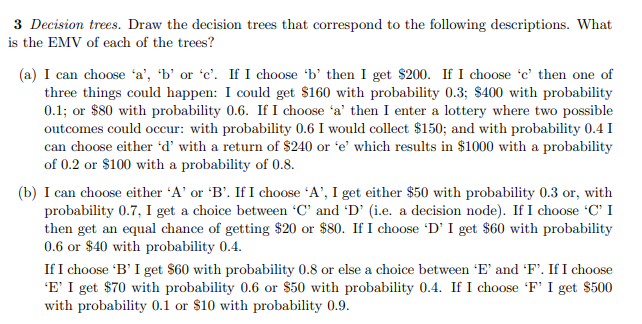(a) I can choose 'a', 'b' or 'c'. If I choose 'b' then I get $200. If I choose 'c' then one of three things could happen: I could get $160 with probability 0.3; $400 with probability 0.1; or $80 with probability 0.6. If I choose 'a' then I enter a lottery where two possible outcomes could occur: with probability 0.6 I would collect $150; and with probability 0.4 I can choose either 'd’ with a return of $240 or 'e' which results in $1000 with a probability of 0.2 or $100 with a probability of 0.8. (b) I can choose either 'A' or 'B'. If I choose A', I get either $50 with probability 0.3 or, with probability 0.7, I get a choice between C' and 'D' (i.e. a decision node). If I choose C' I then get an equal chance of getting $20 or $80. If I choose 'D' I get $60 with probability 0.6 or $40 with probability 0.4. If I choose B' I get $60 with probability 0.8 or else a choice between 'E' and F'. If I choose 'E' I get $70 with probability 0.6 or $50 with probability 0.4. If I choose 'F' I get $500 with probability 0.1 or $10 with probability 0.9.
(a) I can choose 'a', 'b' or 'c'. If I choose 'b' then I get $200. If I choose 'c' then one of three things could happen: I could get $160 with probability 0.3; $400 with probability 0.1; or $80 with probability 0.6. If I choose 'a' then I enter a lottery where two possible outcomes could occur: with probability 0.6 I would collect $150; and with probability 0.4 I can choose either 'd’ with a return of $240 or 'e' which results in $1000 with a probability of 0.2 or $100 with a probability of 0.8. (b) I can choose either 'A' or 'B'. If I choose A', I get either $50 with probability 0.3 or, with probability 0.7, I get a choice between C' and 'D' (i.e. a decision node). If I choose C' I then get an equal chance of getting $20 or $80. If I choose 'D' I get $60 with probability 0.6 or $40 with probability 0.4. If I choose B' I get $60 with probability 0.8 or else a choice between 'E' and F'. If I choose 'E' I get $70 with probability 0.6 or $50 with probability 0.4. If I choose 'F' I get $500 with probability 0.1 or $10 with probability 0.9.
Practical Management Science
6th Edition
ISBN:9781337406659
Author:WINSTON, Wayne L.
Publisher:WINSTON, Wayne L.
Chapter9: Decision Making Under Uncertainty
Section9.2: Elements Of Decision Analysis
Problem 2P
Related questions
Question
A and B please

Transcribed Image Text:3 Decision trees. Draw the decision trees that correspond to the following descriptions. What
is the EMV of each of the trees?
(a) I can choose 'a', 'b' or 'c'. If I choose 'b' then I get $200. If I choose 'c' then one of
three things could happen: I could get $160 with probability 0.3; $400 with probability
0.1; or $80 with probability 0.6. If I choose 'a' then I enter a lottery where two possible
outcomes could occur: with probability 0.6 I would collect $150; and with probability 0.4 I
can choose either 'd' with a return of $240 or 'e' which results in $1000 with a probability
of 0.2 or $100 with a probability of 0.8.
(b) I can choose either 'A' or 'B'. If I choose A', I get either $50 with probability 0.3 or, with
probability 0.7, I get a choice between 'C' and 'D' (i.e. a decision node). If I choose C' I
then get an equal chance of getting $20 or $80. If I choose 'D' I get $60 with probability
0.6 or $40 with probability 0.4.
If I choose 'B' I get $60 with probability 0.8 or else a choice between 'E' and F'. If I choose
'E' I get $70 with probability 0.6 or $50 with probability 0.4. If I choose 'F' I get $500
with probability 0.1 or $10 with probability 0.9.
Expert Solution
This question has been solved!
Explore an expertly crafted, step-by-step solution for a thorough understanding of key concepts.
Step by step
Solved in 3 steps with 2 images

Recommended textbooks for you

Practical Management Science
Operations Management
ISBN:
9781337406659
Author:
WINSTON, Wayne L.
Publisher:
Cengage,

Practical Management Science
Operations Management
ISBN:
9781337406659
Author:
WINSTON, Wayne L.
Publisher:
Cengage,